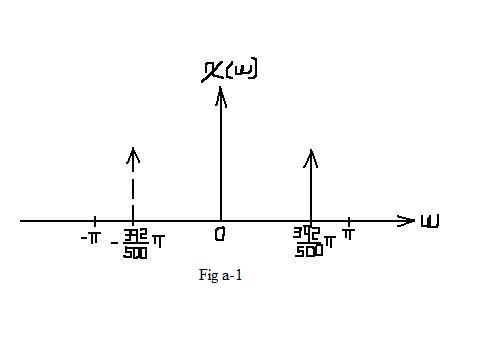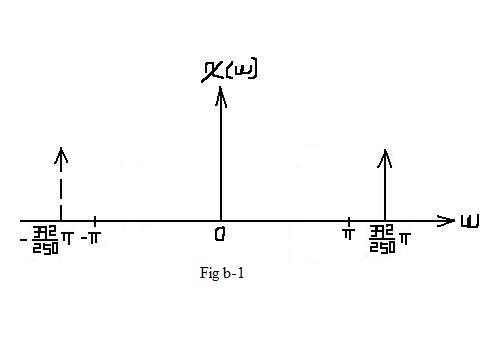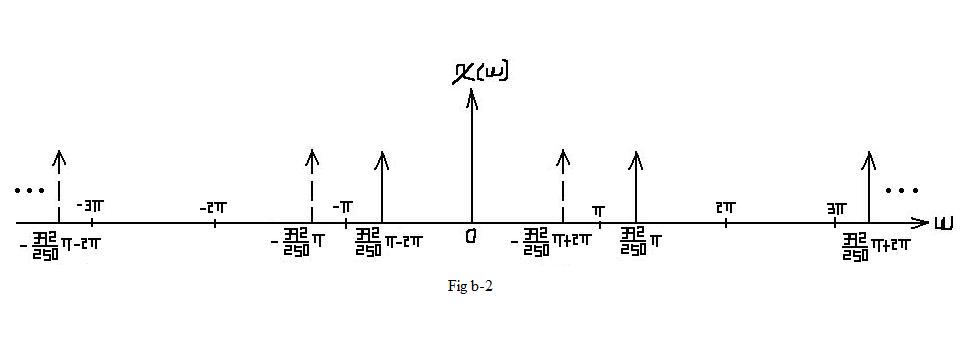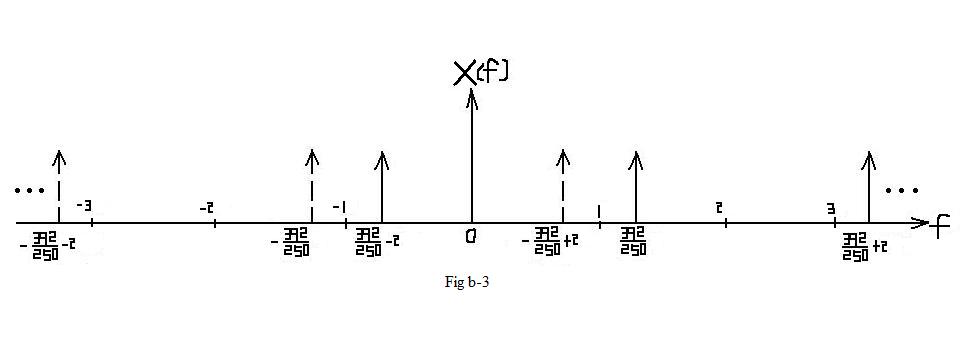| Line 97: | Line 97: | ||
---- | ---- | ||
==Question 2== | ==Question 2== | ||
| + | |||
| + | (Under construction) | ||
---- | ---- | ||
[[Hw2_ECE438F11|Back to Homework2]] | [[Hw2_ECE438F11|Back to Homework2]] | ||
[[2011_Fall_ECE_438_Boutin|Back to ECE438, Fall 2011, Prof. Boutin]] | [[2011_Fall_ECE_438_Boutin|Back to ECE438, Fall 2011, Prof. Boutin]] | ||
Revision as of 09:24, 10 September 2011
Homework 2, ECE438, Fall 2011, Prof. Boutin
Question 1
Pick a note frequency f0 = 392H'z
| x(t) = c'o's(2πf0t) = c'o's(2π * 392t) |
| $ a.\ Assign\ sampling\ period\ T_1=\frac{1}{1000} $ |
| $ 2f_0<\frac{1}{T_1}, \ No\ aliasing\ occurs. $ |
$ \begin{align} x_1(n) &=x(nT_1)=cos(2\pi *392nT_1)=cos(2\pi *\frac{392}{1000}n) \\ &=\frac{1}{2}\left( e^{-j2\pi *\frac{392}{1000}n} + e^{j2\pi *\frac{392}{1000}n} \right) \\ \end{align} $
| $ 0<2\pi *\frac{392}{1000}<\pi $ |
| $ -\pi<-2\pi *\frac{392}{1000}<0 $ |
$ \begin{align} \mathcal{X}_1(\omega) &=2\pi *\frac{1}{2} \left[\delta (\omega -2\pi *\frac{392}{1000}) + \delta (\omega + 2\pi *\frac{392}{1000})\right] \\ &=\pi \left[\delta (\omega -2\pi *\frac{392}{1000}) + \delta (\omega + 2\pi *\frac{392}{1000})\right] \\ \end{align} $
| $ for\ all\ \omega $ |
| $ \mathcal{X}_1(\omega)=\pi* rep_{2\pi} \left[\delta (\omega -2\pi *\frac{392}{1000}) + \delta (\omega + 2\pi *\frac{392}{1000})\right] $ |
| In this situation, no aliasing occurs. In the interval of [ − π,π], which represents one period, the frequcy spectrum remains the same as Fig a-1. |
| $ b.\ Assign\ sampling\ period\ T_2=\frac{1}{500} $ |
| $ 2f_0>\frac{1}{T_2}, \ Aliasing\ occurs. $ |
$ \begin{align} x_2(n) &=x(nT_2)=cos(2\pi *392nT_2)=cos(2\pi *\frac{392}{500}n) \\ &=\frac{1}{2}\left( e^{-j2\pi *\frac{392}{500}n} + e^{j2\pi *\frac{392}{500}n} \right) \\ \end{align} $
| $ \pi<2\pi *\frac{392}{500}<2\pi $ |
| $ -2\pi<-2\pi *\frac{392}{500}<\pi $ |
| $ \mathcal{X}_2(\omega)=\pi \left[\delta (\omega -2\pi *\frac{392}{500}) + \delta (\omega + 2\pi *\frac{392}{500})\right] $ |
| $ X_2(f)=\frac{1}{2}\left[\delta (f -\frac{392}{500}) + \delta (f + \frac{392}{500})\right] $ |
| $ for\ all\ \omega $ |
| $ \mathcal{X}_2(\omega)=\pi* rep_{2\pi} \left[\delta (\omega -2\pi *\frac{392}{500}) + \delta (\omega + 2\pi *\frac{392}{500})\right] $ |
| $ X_2(f)=\frac{1}{2}rep_2\left[\delta (f -\frac{392}{500}) + \delta (f + \frac{392}{500})\right] $ |
| In this situation, aliasing DO occurs. In the interval of [ − π,π], which represents one period, the frequcy spectrum is different from Fig b-1. |
Question 2
(Under construction)






